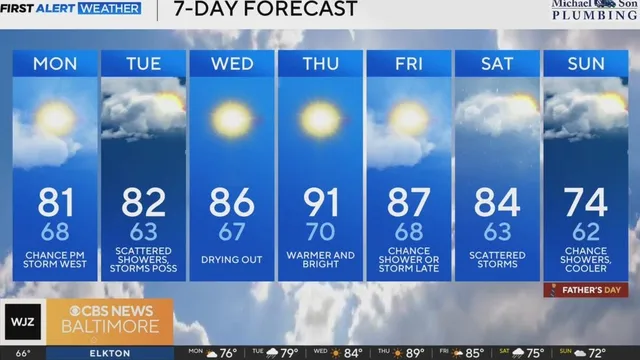
Maryland braces for hottest temperatures of the season this week
2025-06-11 14:54- Maryland is experiencing a shift to summer-like heat with temperatures expected to approach 90 degrees by Thursday.
- A cold front will pass through, bringing slight chances for localized storms while hitting midweek highs in the upper 80s.
- The weekend forecast indicates a significant change with widespread storm chances and cooler temperatures arriving.
Express your sentiment!
Insights
In Maryland, a wave of summer-like temperatures is forecasted to take over the state starting this week, culminating on Thursday with temperatures anticipated to climb near the 90-degree mark. This warm-up follows earlier seasonal temperatures, which saw highs in the upper 70s to low 80s on Monday, and a gradual clearing of storms prompted cooler overnight lows settling around 70 degrees. By midweek, as a cold front approaches and passes through, this surge in warmth will become particularly pronounced, with Maryland's residents experiencing their first true taste of summer. The midweek weather also signals a ramp-up in humidity levels, alongside heightened chances for some isolated thunderstorms. Looking ahead toward Friday, conditions remain hot and humid, and while isolated storms may form in the afternoon, their coverage is expected to be limited. However, as the weekend approaches, a significant shift in the weather pattern arises with a stronger cold front predicted, leading to increased storm chances on Saturday and into Father's Day on Sunday, when cooler temperatures in the 70s are likely. This unsettled weather pattern may persist, with additional showers and storms possible early next week, as temperatures hold steady in the 70s. By late next week, however, another wave of warmth may unfold, potentially bringing temperatures back toward the 90-degree mark as sunshine regains dominance in the forecast.
Contexts
Humidity plays a significant role in shaping summer temperatures, influencing human comfort levels and altering weather patterns. As air moisture content increases, it can lead to higher heat indices, which represent the "feels-like" temperature that combines air temperature with humidity. For instance, a day with a temperature of 90°F can feel much hotter, even approaching 105°F or more, depending on the humidity level. This elevated heat index can pose health risks, particularly for vulnerable populations such as the elderly and those with preexisting health conditions. Understanding the interplay between humidity and temperature is critical in designing effective public health strategies and responses to extreme heat events. The relationship between humidity and temperature is primarily governed by physical principles, such as evaporation and heat absorption. During the summer months, when temperatures rise, humidity levels can also increase due to several factors, including increased evaporation from bodies of water, soil moisture, and plant transpiration. This phenomenon is particularly pronounced in tropical and subtropical regions, where high temperatures coincide with high humidity, leading to discomfort and heat-related health issues. The impact of humidity on temperature regulation is not limited to direct effects on human perception; it also influences ecosystems, agricultural productivity, and energy consumption patterns. Climate change further complicates the dynamics of humidity and temperature. As global temperatures rise due to increasing greenhouse gas emissions, we can expect changes in precipitation patterns and increased humidity in certain areas, while others may experience drier conditions. This variability creates challenges for predicting future summer temperature patterns and prepares for their implications on health, agriculture, and water supply. Moreover, with rising temperatures and shifting humidity levels, we may see an increase in the frequency and intensity of extreme weather events, such as heat waves, which can exacerbate the already significant impacts of high humidity. To mitigate the adverse effects of high humidity and temperature, strategies must be developed that prioritize public health and environmental sustainability. These may include enhancing green spaces in urban areas to regulate temperature and humidity, increasing access to air conditioning, and raising awareness about the dangers of heat-related illnesses. Furthermore, integrating humidity and temperature considerations into urban planning and public policy is essential for fostering resilience in the face of climate change. Overall, the impact of humidity on summer temperatures presents multifaceted challenges, requiring an interdisciplinary approach to effectively address these concerns in society.